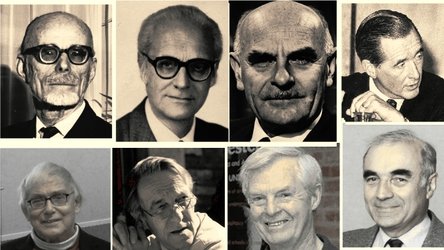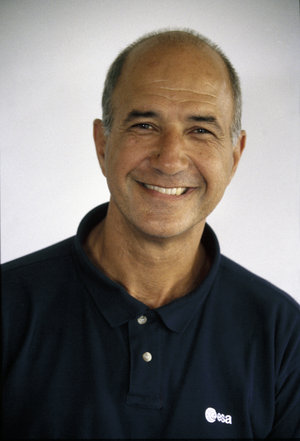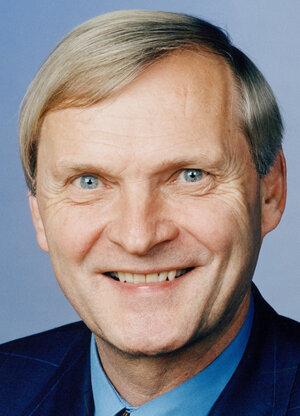Spacelab D1 mission – 25 years ago
Space Shuttle Challenger flight STS-61A carried Wubbo Ockels, Ernst Messerschmid and Reinhard Furrer, and marked a number of firsts in European human spaceflight, including the first Dutch citizen in space.
Between 30 October and 6 November 1985, these three European astronauts served as payload specialists (science astronauts) on the first spaceflight with a crew of eight (STS-61A still holds the record for the largest crew aboard any single spacecraft for the entire period from launch to landing).
This was only the fourth flight of Spacelab, the ESA-designed laboratory module carried in the Shuttle’s payload bay, but this was the first time that an entire payload was controlled from outside NASA’s mission control centres.

Called the Spacelab D1 mission, it was the first to have German mission management and to be controlled from the German Space Operations Centre of the German Institute of Aviation and Spaceflight Research and Development (DFVLR, a precursor of present-day DLR) at Oberpfaffenhofen, near Munich.
Wubbo Ockels became the second ESA astronaut and the first Dutch citizen in space (not the first Dutch-born astronaut, he was preceded by naturalised American Lodewijk van den Berg, who flew into space five months earlier). Messerschmid and Furrer became the joint third German astronauts in space (after Sigmund Jaehn and Ulf Merbold).
The NASA crew members were Commander Hank Hartsfield and Pilot Steve Nagel, with Mission Specialists Bonnie Dunbar, Jim Buchli and Guy Bluford.

More than 75 scientific experiments were completed in the areas of physiological sciences, materials science, biology and navigation. At the end of the Spacelab D-1 mission, Ockels, Messerschmid and Furrer had travelled 110 Earth orbits, and logged over 168 hours in space.
Wubbo Ockels, a nuclear physicist, was selected as one of three European payload specialists to train for the Spacelab missions, together with Ulf Merbold and Claude Nicollier, in 1978. In May 1980, Ockels began the basic astronaut training for mission specialist at NASA’s Johnson Space Center, Houston, USA.
He completed the training in August 1981 and joined the Spacelab 1 crew as a back-up payload specialist for the first mission of ESA’s Spacelab. During this mission in 1983, he served as ground-communicator and liaison scientist for the crew on STS-9/Spacelab 1.
After his flight on Spacelab D1, Ockels worked at ESA’s research and technology centre, ESTEC, in Noordwijk, the Netherlands, becoming Head of ESA’s Education and Outreach Office. In 2003, he left ESA to study the exploitation of alternative sources of energy at the Delft University of Technology.
Physicist Ernst Messerschmid participated in the same ESA initial astronaut selection as Ockels, but was not chosen. Instead he went to work for the DFVLR at Oberpfaffenhofen on satellite communications. He was, however, selected in 1983 by the DFVLR as a research astronaut, and then two years of training prepared him for the D1 mission.
After the D1 mission, Messerschmid became the Director of the Institute of Space Systems at the University of Stuttgart before heading ESA’s European Astronaut Centre in Cologne between 2000 and 2004. Today, Messerschmid is a member of the steering committee of the Innovationsrat (Innovation Council) in Baden-Württemberg, Germany.

Another physicist, Reinhard Furrer was also selected by the DFVLR in 1983. Furrer was born in 1940, in Austria. Furrer studied physics at the University of Kiel, later transferring to the Free University of Berlin, where he received his doctorate in 1972. In 1974 he became assistant professor in Stuttgart and in 1979 qualified for full professorship. From 1980-81, he worked at the University of Chicago and the Argonne National Laboratory, Chicago.
After his flight, he became a professor and director of the Institute for Space Sciences at the Free University of Berlin. Privately, Furrer – an avid pilot who had received his first pilot's license in 1974 – undertook many flights in single-engine sports aircraft. Tragically, Furrer died in a plane crash during an airshow at the Johannisthal Airfield, Berlin, in 1995.















 Germany
Germany
 Austria
Austria
 Belgium
Belgium
 Denmark
Denmark
 Spain
Spain
 Estonia
Estonia
 Finland
Finland
 France
France
 Greece
Greece
 Hungary
Hungary
 Ireland
Ireland
 Italy
Italy
 Luxembourg
Luxembourg
 Norway
Norway
 The Netherlands
The Netherlands
 Poland
Poland
 Portugal
Portugal
 Czechia
Czechia
 Romania
Romania
 United Kingdom
United Kingdom
 Slovenia
Slovenia
 Sweden
Sweden
 Switzerland
Switzerland





































